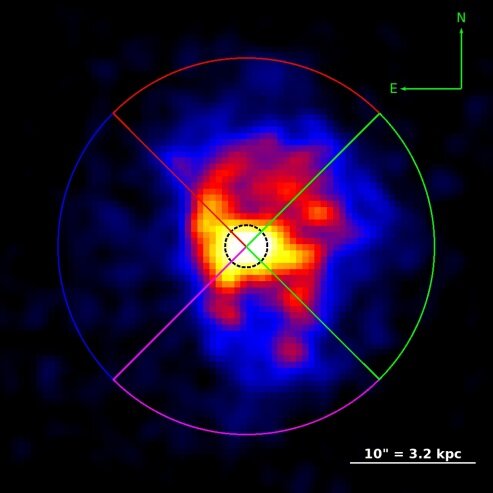
Using NASA’s Chandra X-ray observatory, astronomers from the University of Alabama in Huntsville have investigated the central region of the galaxy NGC 1600, focusing on its ultramassive black hole (UMBH). Results of the study, presented in a paper published February 11 on the arXiv pre-print server, shed more light on the properties of this UMBH.
At a distance of about 150,000,000 light years away from the Earth, NGC 1600 is an elliptical galaxy in the constellation Eridanus. It has a mass of around 1 trillion solar masses, and despite the fact that it belongs to a relatively small group of only a few galaxies, NGC 1600 hosts an extremely massive black hole—with mass estimated to reach 17 billion solar masses.
The properties of the UMBH in NGC 1600, especially its huge mass and relatively close proximity, make it an excellent target for which spatially resolved temperature and density profiles can be obtained within the Bondi radius—a calculated radius of the region around the galaxy from which surrounding medium is likely to be drawn in and accreted. Hence, University of Alabama’s James Runge and Stephen A. Walker decided to employ Chandra in order to conduct such study.
“Using new deep Chandra observations in conjunction with archival Chandra data of NGC 1600, we have determined the temperature and density profiles within the Bondi accretion radius, down to a radius of ∼0.16 kpc from the central ultramassive black hole,” the researchers wrote in the paper.
The study analyzed the hot gas properties within the Bondi accretion radius (estimated to be between 1,240 and 1,760 light years. The researchers detected two statistically significant temperature components within 9,780 light years and found that the temperature profile increases very mildly within the Bondi radius.
The findings are surprising, as they are in contrast with the expected increase in temperature towards the center one would expect from classical Bondi accretion, which suggests that the dynamics of the gas are not being determined by the black hole. However, the astronomers noted that there is a possibility that the temperature increases on scales smaller than those that can be investigated.
The mass accretion rate at the Bondi radius was calculated to be at a level of about 0.1-0.2 solar masses per year. The researchers found that inside the Bondi radius, the density profile follows a power law flatter than expected for classical Bondi accretion.
“The density profile follows a relatively shallow ρ ∝ r−[0.61±0.13] relationship within the Bondi radius, which suggests that the true accretion rate on to the black hole may be lower than the classical Bondi accretion rate,” the astronomers explained.
The research also found that the calculated entropy drops below a critical value of 30 keV cm2 within 9,800 light years, what is characteristic for systems with thermal instabilities. https://phys.org/news/2021-02-ultramassive-black-hole-ngc.html








Recent Comments